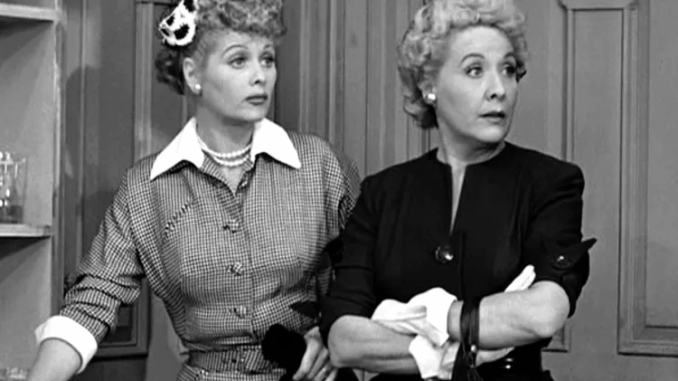
The True Story: Why Lucille Ball Wore Black on Her Wedding Day to Desi Arnaz
Lucille Ball and Desi Arnaz were Hollywood’s ultimate power couple, their tumultuous, passionate romance becoming the stuff of legend, immortalized through the iconic facade of I Love Lucy. From their whirlwind courtship to their groundbreaking interracial marriage, nearly every detail of their lives was larger than life—except, perhaps, for their wedding attire.
When the couple eloped in 1940, Lucille Ball did not wear the flowing white gown of cinematic tradition. Instead, she tied the knot with the Cuban bandleader in a strikingly unconventional choice: a little black wool dress. The reason behind this deeply un-Hollywood decision is not rooted in a dramatic fashion statement or a rebellious gesture, but in the wonderfully practical and impulsive nature of the “Queen of the B’s” herself.
The Whirlwind Elopement: A Marriage of Impulse
The story of the black wedding dress begins, appropriately, with the blazing speed of Ball and Arnaz’s romance. They met in 1940 while filming the musical ‘Too Many Girls’ for RKO Pictures. Arnaz, then a charismatic 23-year-old bandleader, was six years younger than the 28-year-old studio contract player. Their chemistry was immediate and explosive, a physical attraction so palpable it captivated everyone on set.
Within just six months of meeting, the two were so enraptured that they decided to marry. The problem was timing. Arnaz was scheduled to perform a show at the Roxy Theatre in New York City, and Ball was in town for a magazine interview—one ironically titled, “Why Lucille Ball Prefers to Remain a Bachelor Girl.”
In a classic Hollywood impulse move, Desi Arnaz proposed, and on November 30, 1940, they decided to elope. The location was a Justice of the Peace ceremony in Greenwich, Connecticut.
The Practicality of a Black Wool Dress
The simple, unromantic truth of why Lucille Ball wore black is that she simply wore what she had on hand.
Ball later recounted the details of the rushed ceremony in her autobiography, stating that the whole affair was so sudden there was no time for traditional bridal preparations. She wrote:
“All I had was a little black wool number I’d been wearing all day. When I thought about all the appropriately beautiful things I had in my trunk but not available for eight a.m., I was fit to be tied.”
The wedding was an early morning affair, and the attire she happened to be wearing when they made the spontaneous decision to drive to Connecticut was the aforementioned practical black wool dress. The wedding was not a lavish, pre-planned event but a testament to their mutual impatience and ardor. In that moment, the passion for each other outweighed all considerations of fashion and tradition.
The “black wool number” was an everyday, casual dress—likely a simple, warm day dress appropriate for the late November New York climate. It was, in essence, an anti-statement, a reflection of the fact that the two future television giants were so focused on becoming husband and wife that every other detail was rendered irrelevant.
Challenging the Myth of the White Wedding
In modern culture, the white wedding dress is a deeply entrenched tradition symbolizing purity, innocence, and celebration. However, as of 1940, the trend was still relatively new. Queen Victoria is often credited with popularizing the white gown when she married Prince Albert in 1840. Before that, brides wore their finest dress, which was often a rich color that could be worn again.
Lucille Ball’s black dress, while born of necessity, perfectly encapsulates the non-conformist nature of her marriage to Desi Arnaz. It served as an early indicator that their union would defy convention:
- Age Difference: Ball was six years older than Arnaz, a significant social taboo at the time, which they famously concealed by altering their ages on the marriage license.
- Interracial Marriage: Theirs was one of the highest-profile interracial marriages in Hollywood, with Arnaz being Cuban-American. This was a bold public statement in a country where interracial marriage was still illegal in many states and a topic often skirted by the studio system.
- The Second Wedding: Recognizing the impulsive nature of their elopement, and possibly wanting a more traditional, sanctified ceremony, the couple remarried in a Catholic church in 1949. For this second, quieter wedding, Ball did wear a more conventional blue satin dress, finally indulging in the ceremonial aspect of matrimony.
The image of Ball in the black wool dress from her first marriage is often confused with images from her 1946 film ‘Two Smart People,’ where she wore a stylish dark gown that many mistakenly believe was her actual wedding dress. In reality, her 1940 wedding was far less glamorous.
A Fitting Start for the Ricardos
Ultimately, the choice of a simple, black dress was perfectly fitting for the impulsive and complicated relationship that followed. Ball and Arnaz’s marriage was always characterized by the intense reality behind the public persona. It was passionate, messy, brilliant, and deeply human—much like the practical dress that marked its beginning.
When they reconciled after Ball first filed for divorce in 1944, their determination to save their marriage led them to develop the one project that would allow them to work together and remain close: ‘I Love Lucy.’ The show became the platform for their joint genius, creating the perfect, enduring television marriage that their real one could never quite achieve.
Lucille Ball’s black wedding dress, therefore, is not a symbol of mourning or rebellion, but a timeless anecdote about a Hollywood icon whose priority was not the perfect picture, but the perfect man. It serves as a reminder that for Lucy and Desi, their story was always about authentic, unvarnished love, even when it lacked the traditional flourishes of a star-studded white wedding.
